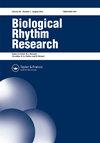巴基斯坦旁遮普邦木尔坦及其周边地区社会经济贫困的城市游牧社区饲养的牛羊中贾第虫病的流行率和风险决定因素
IF 0.9
4区 生物学
Q3 BIOLOGY
引用次数: 1
摘要
摘要:本研究报告了贾第虫病在巴基斯坦木尔坦游牧社区的牛羊群体中的共流行情况。为此,从游牧民族饲养的牛(n = 92)和羊(n = 92)中共收集了184份粪便样本。采用种特异性ELISA试剂盒检测十二指肠贾第虫粪抗原。结果显示,贾第虫病总患病率为21.20%,绵羊和牛的贾第虫病总患病率分别为19.18%和23.91%。年龄、临床体质和饮水水源与牛羊贾第虫病的发生有显著相关性(P < 0.05)。绵羊的品种、胃肠道病史和常规疫苗接种也是显著的危险因素(P < 0.05),而牛无显著危险因素。除虫史与贾第虫病有显著相关性(P < 0.05)。性别、畜群规模、农民受教育程度、饲养方式、生理状况、与野生动物和贾第虫易感动物接触情况、住房卫生状况与贾第虫病无显著相关(P < 0.05)。综上所述,游牧民饲养的牛羊感染了贾第虫病,可能对其周边地区的易感动物和人群构成严重威胁。本文章由计算机程序翻译,如有差异,请以英文原文为准。
Copro-ELISA-based prevalence and risk determinants of giardiasis in cattle and sheep populations raised by socio-economically deprived urban nomadic communities located in and around Multan, Punjab-Pakistan
ABSTRACT This study reports the copro-prevalence of giardiasis in sheep and cattle populations of nomadic communities in Multan-Pakistan. For this purpose, a total of 184 faecal samples were collected from cattle (n = 92) and sheep (n = 92) raised by the nomads. All samples were analyzed by using species-specific ELISA kits for the detection of copro-antigen of Giardia duodenalis. Results showed that the overall prevalence of giardiasis was 21.20%, whereas, in sheep and cattle, the prevalence rates were 19.18% and 23.91%, respectively. Age, clinico-physical status and drinking water source showed significant association (P < 0.05) with giardiasis in both sheep and cattle. Breed, history of gastrointestinal problems and routine vaccination were also significant (P < 0.05) risk factors in sheep but not in cattle. Deworming history had a significant association (P < 0.05) with giardiasis in cattle population only. Conversely, sex, herd size, farmers’ educational status, feeding pattern, physiological status, contact with wildlife and Giardia-susceptible animals and hygienic condition of housing facility showed non-significant association (P > 0.05) with giardiasis. In conclusion, the cattle and sheep raised by the nomads are infected with giardiasis and may pose a serious threat to susceptible animal and human populations in their surrounding regions.
求助全文
通过发布文献求助,成功后即可免费获取论文全文。
去求助
来源期刊

Biological Rhythm Research
生物-生理学
CiteScore
3.00
自引率
9.10%
发文量
34
审稿时长
6-12 weeks
期刊介绍:
The principal aim of Biological Rhythm Research is to cover any aspect of research into the broad topic of biological rhythms. The area covered can range from studies at the genetic or molecular level to those of behavioural or clinical topics. It can also include ultradian, circadian, infradian or annual rhythms. In this way, the Editorial Board tries to stimulate interdisciplinary rhythm research. Such an aim reflects not only the similarity of the methods used in different fields of chronobiology, but also the fact that many influences that exert controlling or masking effects are common. Amongst the controlling factors, attention is paid to the effects of climate change on living organisms. So, papers dealing with biometeorological aspects can also be submitted.
The Journal publishes original scientific research papers, review papers, short notes on research in progress, book reviews and summaries of activities, symposia and congresses of national and international organizations dealing with rhythmic phenomena.
 求助内容:
求助内容: 应助结果提醒方式:
应助结果提醒方式:


